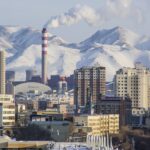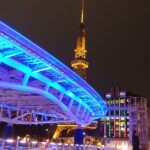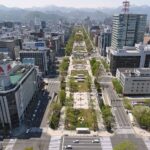For both visitors and locals, public transit in Boston is a practical and cost-effective choice. It is simple to navigate the city thanks to the Massachusetts Bay Transportation Authority’s (MBTA) large network of buses, subways, commuter rail lines, and boat services. The cost of using the public transportation system is reasonable, and you can pay with cash, credit/debit cards, or a CharlieCard. Additionally, using ride-sharing services like Uber and Lyft is one of the most well-liked ways to get around the Boston area.
Metro system in Boston – Basic information
One of the oldest and largest metro systems in the country is found in Boston. It consists of five lines, servicing stops at more than 150 stations, on 109 kilometers of track. The Red Line and the Orange Line are the two primary lines that make up the system. While the Orange Line travels from Oak Grove in the north to Forest Hills in the south, the Red Line travels from Alewife in the north to Ashmont in the south. In Boston’s city center, both railroads converge. The Blue, Green, and Silver Lines make up the remaining three lines. While the Green Line travels from Lechmere to Riverside, the Blue Line goes from Bowdoin to Wonderland. Logan Airport and Dudley Square are connected by the Silver Line. For both locals and tourists, Boston’s metro system offers a handy mode of public transit.
The lines of the Boston Subway system
Green Line
The Green Line is the most established of all the lines, and it is the one that links the villages of Government Center and Oak Grove. Along this route, passengers have the option of stopping at several destinations, such as Kenmore Square, Fenway Park, and Cleveland Circle. The B, C, D, and E lines are the other three lines of the city’s subway system that travel to other neighborhoods in addition to the Green Line.
Red line
The Red Line is the one with the most ridership out of the four lines because it runs from Alewife in the north to Ashmont in the south. In addition to that, it has four different service branches that travel across different areas of the city. These branches are labeled A, B, C, and D. Passengers are permitted to exit the vehicle at Harvard Square, Downtown Crossing, and Park Street.
Orange Line
The Orange Line extends all the way from Oak Grove, which is located in the north, to Forest Hills, which is located in the south. In spite of the fact that it is the shortest of the four lines, it nevertheless makes stops at well-known destinations such as Back Bay and the Tufts Medical Center.
Blue Line
The final stop is on the Blue Line, which runs from Bowdoin in the east to Wonderland in the west and connects both directions. This is the sole line that runs through East Boston, and it stops at Maverick and Airport stations along the way.
Silver Line
The Massachusetts Bay Transportation Authority (MBTA) is in charge of operating what is known as the Silver Line, which is a network of bus lines that runs through Boston and Chelsea, Massachusetts. Despite the fact that it is operated as a part of the MBTA bus system, the moniker “bus rapid transit” (BRT) refers to it as a part of the MBTA subway system. Six different courses are run, each in its own separate corridor. During the weekdays in 2019, the Silver Line was utilized by 39,000 passengers.
Map of Boston Metro 2023 – Free Download in PDF

Click and download the map of Boston underground system for 2023
Any person living in the Boston region needs the Boston Metro 2023 map. You may get a current and simple-to-use map of the full metropolitan area with this free PDF download. Tourists will particularly benefit from this map as they can easily find restaurants, attractions, and other areas of interest. Along with information about the city’s public transportation system, it also offers the most recent bus and train itineraries. The Boston Metro 2023 map is crucial for navigating the city and its surroundings whether you’re a local or a visitor.
Public transport tickets in Boston – Best types for travelers & actual prices
The abundance of ticketing alternatives offered for public transit makes getting to Boston considerably simpler. It’s never been less expensive or easier to get about the city. Depending on your needs and budget, there are a number of ticketing alternatives available, whether you’re a local or a visitor.
The MBTA provides day passes and single-riding options for people who prefer to pay per ride. The price for a single ride is $2.45, while a day pass is $12.00. The 24-hour period is covered by the unlimited ride 1-day pass.
The MBTA provides a 7-day pass for visitors who intend to stay in the city for a few days or longer. Unlimited rides are available with the 7-day pass for $22.00 during the course of the 7-day term. The MBTA also provides a monthly pass for $90.00 that entitles the holder to unlimited trips over the course of 30 days.
The 1-day pass is the best choice for visitors who will be in Boston for three days. The most economical choice for transient passengers is the 1-day pass, which entitles the holder to unlimited rides for a full 24 hours. This is particularly true if you want to take the bus or train more than once each day.
Whatever your requirements, Boston has a number of ticketing choices for public transportation that can satisfy them. There are options for everyone, from monthly passes to single-ride tickets. The 1-day pass is the most economical choice for visitors staying three days.
Summary of fares for public transport in Boston
- A single trip costs $2.45.
- A 24-hour day pass costs $12.
- Seven days of unlimited rides for $22.00
- $90.00 for a 30-day period of unlimited rides with a monthly pass
Timetables & Schedules of the Boston Metro system
Monday through Saturday, the Boston Metro system is open from 5 AM to 12:30 AM, and on Sundays, it is open from 6 AM to 12:30 AM. Depending on the line and the time of day, trains run every 4 to 12 minutes. The trains run every 4-6 minutes during peak hours and every 12 minutes during off-peak hours. Each line’s final train departs its terminus 30 minutes before the system shuts down. During rush hour, certain lines also offer express service. Overall, getting around Boston is easy and dependable with the help of the Metro system.
What Are Other Options For Public Transportation In Boston?
In the busy city of Boston, the metro system is one of the most used means of transportation. But there are other ways to get around Boston using the public transit system. Here are some other Boston public transit options, whether you’re searching for a less expensive option or simply want to experience the city in a new way.
how does the public bus transportation work in Boston
Boston’s public bus system is an effective and reasonably priced means to get around the city. The Greater Boston area’s bus system, which is run by the Massachusetts Bay Transportation Authority (MBTA), covers more than 150 routes and gives locals and visitors access to the majority of the city’s attractions, establishments, and neighborhoods.
The MBTA’s bus network is spread out over the city’s many streets and includes stops at significant attractions, including Fenway Park, Boston Common, and Harvard Square. The majority of buses run daily between 5 a.m. and 1 a.m., while certain routes run continuously.
There are numerous fare options available from the MBTA, including single-ride tickets, passes, and monthly passes. Exact change or a CharlieCard, a reloadable fare card, must be used to pay for all fares. A CharlieCard can be purchased by passengers at any MBTA station or retail store.
The Silver Line, the 15, 66, and 86 bus routes, as well as the 1, 8, and 47 bus routes, are the bus lines that Boston residents use the most. With stops at South Station, Logan Airport, and the Seaport District, the Silver Line is a rapid transit line. The most well-liked local bus lines run through Boston’s downtown and the neighboring areas on routes 15, 66, and 86. The most popular bus routes in the city are the 1, 8, and 47, which pass by the well-known tourist attractions of Cambridge, Harvard Square, and Fenway Park.
Boston’s public bus system is a fantastic way to explore the city and all of its attractions. With the MBTA’s enormous bus network, it’s simple to get around whether you’re a local or a guest. You can easily explore the city if you pay attention to the fare and have a basic understanding of the busiest routes.
How do the public TRAINS work in Boston?
Five commuter train lines, including the Framingham/Worcester, Fitchburg, Haverhill, Lowell, and Newburyport/Rockport lines, are run by the MBTA in the Greater Boston region. Cambridge, Newton, Waltham, and Salem are just a few of the towns and communities in and around the Greater Boston area that can be reached directly through the commuter rail lines. The Massachusetts Bay Lines further offer direct service to New York City, Providence, and other New England cities.
How To Get From Boston Logan International Airport (BOS) To The City Center With Public Transport?
Going to Boston? Finding a way to go from Boston Logan International Airport to the city core is one of the first stages. To help you reach your location quickly and safely, there are a number of public transit choices available
- Taking the MBTA Blue Line is the simplest way to go from Boston Logan International Airport to the city center. The Blue Line makes stops at Government Center, State Street, and Bowdoin Station on its route from the airport into the city’s core. The Blue Line normally takes 20 minutes to travel from the airport to the city center and operates around-the-clock, seven days a week.
- The Silver Line Bus is an alternative to the MBTA Blue Line if you like. From the airport to the city center, this bus service has stops at South Station, Chinatown, and Boylston Street. The Silver Line Bus travels between the airport and the city center in about 40 minutes and operates twenty-four hours per day, seven days per week.
- Last but not least, you can ride the MBTA Commuter Rail. This rail service stops at North Station and South Station along its route from the airport to the city’s core. The commuter rail travels between the airport and the city center in usually 40 minutes and operates seven days a week from 6 am to 10 night.
You can be confident that you’ll be able to travel from Boston Logan International Airport to the city center promptly and safely no matter which mode of public transportation you decide to use. So, the next time you’re in Boston, make sure to use these public transit choices to quickly and easily reach your location.
how to spend 3 days in Boston?
If you are visiting Boston for the first time, you may be wondering how to make the most of your three days in this historic city. Fortunately, visitors can have a unique experience, enjoy great restaurants chosen by locals, and explore the city’s exciting nightlife. Here is a three-day plan for those wanting to explore the best of Boston.
Day One in Boston
Start your morning with a visit to the Museum of Fine Arts, where you can explore artwork from around the world, including Renaissance masterpieces, Egyptian antiquities, and Asian treasures. Take a break and grab lunch at the nearby Shake Shack before heading over to the Boston Tea Party Ship & Museum. Here you can learn about the pivotal event in American history and explore interactive exhibits. Afterward, take a stroll along the Freedom Trail, which will lead you to some of the city’s most iconic landmarks. End your day with dinner at one of the city’s many award-winning restaurants.
Day Two
Begin your day with a drive to Salem, also known as Witch City, for a day of spooky fun. While here, visit the Salem Witch Museum and the Witch History Museum, both of which will give you a comprehensive look at the witch trials that took place in the 17th century. You can even take a ghost tour of the city. Afterward, head back to Boston and enjoy dinner at one of the city’s best seafood restaurants, such as Neptune Oyster or Neptune Oyster’s sister restaurant, Island Creek Oyster Bar.
Day Three
On your last day in Boston, explore the city’s vibrant nightlife. Start with a stroll down Lansdowne Street to enjoy the music, drinks, and food in Fenway Park. Then, head over to the North End and explore the Italian restaurants, bars, and clubs. Afterward, enjoy a night of live music at one of the city’s many venues, such as The Sinclair, Brighton Music Hall, or Royale. End the night with a late-night snack from an eatery like Mike’s Pastry, known for its cannoli.
These three days in Boston will give you a unique experience, delicious food, and exciting nightlife. Whether you are visiting for the first time or returning for a second trip, you will never forget your time in this beautiful city.
What other metro systems are nearby Boston?
The metro system serving the District of Columbia and its adjacent areas in Virginia and Maryland is called the Washington Metro. With more than 600,000 daily riders, it is one of the busiest public transportation systems in the country. The commuter train network that serves the Philadelphia metropolitan region is called the SEPTA Regional Train. One of the biggest commuter rail networks in the US, it comprises 13 lines and more than 150 stations.
The commuter train network that services the greater New York City area is called Metro-North Railroad. It has five lines, more than 140 stations, and operates throughout Connecticut, New York, and New Jersey.
Summary of our tour guide for Boston
Massachusetts’s Boston is a thriving and busy metropolis. It is home to a multicultural population, top-tier universities, and some of the country’s most famous landmarks. Boston has a robust and reasonably priced public transit system, making it simple to move around the city. To get around the city and its neighboring suburbs, commuters can use the subway, bus, ferry, and commuter rail services. Additionally, there are walking and biking trails, making it simple to get around without a car. The public transit infrastructure in Boston makes it even easier to access this dynamic city.
Top 5 FAQs and answers about Boston public transport?
What forms of public transit are there in Boston?
- The subway, bus, trolley, and commuter rail are the four primary means of transportation in Boston’s public transit system. The oldest and longest of the four is the subway, usually referred to as the “T,” which has five lines that traverse the city and its environs. The bus system, which offers service across the city and links passengers to the subway, is Boston’s second-most popular form of public transit. The trolley system is a collection of light rail lines that mostly connects the western suburbs to the city center. Last but not least, the commuter rail system serves the nearby suburbs and rural towns.
How much does public transit in Boston cost?
- The cost of a one-way fare is $2.00, while an all-day pass is $12.00 for the subway, bus, and trolley systems. The commuter rail fare is determined on the distance traveled, and it can range from $2.25 to $13.75 for a one-way trip.
How do I pay for Boston’s public transportation?
- A CharlieCard, a contactless payment card that can be used to travel the subway, bus, and trolley systems, is the most convenient way to pay for public transportation in Boston. The card can be purchased online or at any subway stop. It can be filled with money or have an unlimited monthly pass loaded onto it.
What are the Boston public transit system’s operating hours?
- Typically, the bus, trolley, and subway systems run from 5:00 am until 12:30 am, seven days a week. On weekdays, the commuter rail system is open from 5:00 am to 1:30 am; on weekends and holidays, it is open from 6:00 am to 1:30 am.
What services are offered to those who are disabled?
- In addition to accessible buses and subway stations, the MBTA also provides paratransit services and special fare concessions for customers with disabilities. Visit the MBTA website for further details.
Useful links







